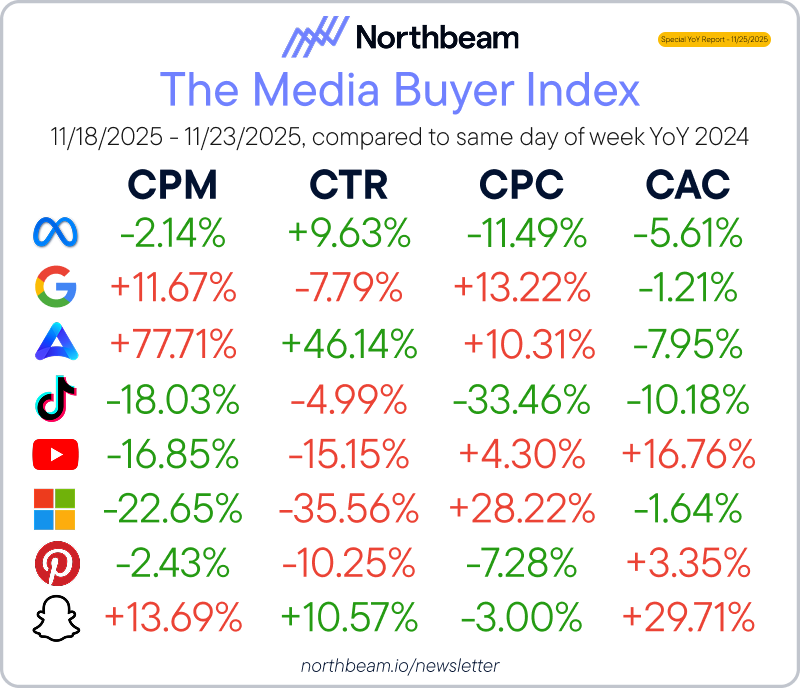AI Isn’t Ranking You. It’s Rewriting You.
⚡Your brand is being quietly reauthored by models trained on other people’s language, media buyer index of the week, and more!
Howdy Readers 🥰
In this newsletter, you’ll find:
⚡ AI Isn’t Ranking You. It’s Rewriting You.
📊 The Real Story Behind CPC, CAC, and ROAS This Week
🏆 Ad of the Day
If you’re new to ScaleUP then a hearty welcome to you, you’ve reached the right place along with 50k+ CEOs, CMOS, and marketers. Let’s get into it, shall we? Oh! Before you forget, if someone forwarded this newsletter to you, don't forget to subscribe to our newsletter so you never miss out!
⚡ AI Isn’t Ranking You. It’s Rewriting You.
There is a new marketing skill emerging quietly under the surface of 2026. It’s not keyword strategy, not technical SEO, not content velocity.
It’s the ability to design language that AI models instinctively choose to quote. Because ranking is no longer the primary signal of authority.
Being referenced is. And references are shaped not by your traffic, but by the linguistic fingerprints you leave behind across the web.
Most teams haven’t realized this shift yet. You’re not competing for position. You’re competing for inclusion inside the sentences AI uses to explain your category.
1. The Invisible Algorithm Nobody Optimizes For
Traditional search engines evaluate pages. AI evaluates patterns of expression.
Models look for:
crisp definitions
authoritative phrasing
consistent terminology
“Statistically reliable” descriptions
have specificity over marketing fluff
These become the building blocks LLMs use when generating answers.
If your brand doesn’t provide these blocks, the model won’t penalize you. It will simply replace you with someone who does. Your problem isn’t visibility, it’s unquotability.
2. The Great Dilution Effect: Why Generic Language Fails
Vague claims once worked in SEO.
“Market-leading,” “best-in-class,” “trusted by thousands.”
In AI search, they collapse. LLMs treat them as semantic noise, non-specific, non-verifiable, and interchangeable.
But statements like:
“Most users complete onboarding in under five minutes.”
“Known for accurate forecasting under unpredictable demand cycles,”
“Recognized for transparent pricing with no usage fees,”
…stick.
They feel factual, so the model remembers them. It begins to reproduce that tone and structure when describing you.
Clarity isn’t a style choice anymore. It’s a ranking factor inside the model’s memory.
3. Semantic Gravity: The System That Determines Who Gets Mentioned
Every industry has gravitational themes:
Fastest, safest, easiest, cheapest, most robust, most recommended.
AI latently organizes brands around these anchor ideas. If your content repeatedly attaches your name to one of these anchors with believable supporting detail, the model starts treating you as a representative example.
This is how brands become default references. They generate so much linguistic mass that the model orbits around their framing. If you lack this gravity, you don’t just fall behind, you fall out of the narrative entirely.
4. Your New Role: Author the Sentences AI Will One Day “Remember.”
The job is no longer “optimize content.”
The job is to author the canonical sentences that the model will reconstruct later.
When someone asks, “Which tools are best for X?”
AI doesn’t pull your copy. It synthesizes the most statistically accurate description of you. Those synthesized sentences become your real brand story, whether you wrote them or not.
5. The Only Way to Know What AI Is Really Saying
Most brands have no idea how AI currently phrases them. Whether they’re categorized correctly. Whether competitors keep showing up in their place. Whether outdated info is polluting responses.
Semrush One gives you the live picture, the exact words, associations, and contexts AI uses to describe you, across platforms like ChatGPT, Gemini, Perplexity, and AI Overview.
It’s the first system that lets marketers monitor how their linguistic reputation is forming in real time. You can see your positioning live with the 14-day free trial here.
📊 The Real Story Behind CPC, CAC, and ROAS This Week
Northbeam’s latest index shows clear platform divergence ahead of peak season. Some channels are becoming efficiency engines while others show growing friction. Reading these signals correctly is now a competitive advantage for performance teams.
The Breakdown:
1. CPC - CPCs eased meaningfully on Meta, TikTok, YouTube, Pinterest, and Snapchat, while Google, Amazon Ads, and Microsoft saw rising click costs. Favor platforms with easing CPC environments where cheaper traffic still aligns with healthy intent, improving blended efficiency.
2. CAC - CAC improved on Meta, Google Shopping, TikTok, and Microsoft, but worsened on YouTube, Pinterest, and Snapchat. Push spend toward platforms demonstrating dependable acquisition efficiency and pull back from channels showing rising new-customer friction.
3. ROAS Results - Meta ROAS grew +10.66%, Amazon +47.64%, TikTok +8.84%, and YouTube +7.34%, while Pinterest -33.03% and Snapchat -10.14% collapsed. Reallocate aggressively into ROAS-positive channels before Black Friday volatility compresses margins.
Meta holds 65.11% share (+1.80%), Google 24.23% (-4.49%), and Amazon 3.30% (+6.98%). Budget gravity reflects trust, high-return channels attract spend fast, signaling where performance marketers expect consistent conversion and scalable efficiency.
🏆 Ad of the Day
What Works:
1) Habit empathy disguised as sale urgency - “Biggest Sale of the Year” anchors to the rational brain, but the copy beneath it addresses the emotional pain point — failure in plant care. The brand doesn’t sell discounts; it sells redemption.
2) Visual framing that flatters the buyer’s self-image - The ad isn’t shot in a greenhouse; it’s shot in a living room. This reframes the plant as decor, not responsibility. The visual message: owning this plant doesn’t make you a caretaker; it makes you someone with taste.
3) Yellow highlights as reward triggers - The soft yellow bubbles aren’t just color accents; they mimic dopamine cues tied to “attention and reward.” By pairing color with each benefit, the brain reads the entire section as a checklist of wins rather than specs.
This ad redefines convenience as competence. It lets people buy not a plant, but proof they’re no longer failing at care, blending aesthetics, self-esteem, and ease into a quiet act of self-redemption.
Advertise with Us
Wanna put out your message in front of over 50,000 best marketers and decision makers?
We are concerned about everything DTC and its winning strategies. If you liked what you read, why not join the 50k+ marketers from 13k+ DTC brands who have already subscribed? Just follow this.
At ScaleUP, we care about our readers and want to provide the best possible experience. That's why we always look for ways to improve our content and connect with our audience. If you'd like to stay in touch, be sure to follow us EVERYWHERE🥰
Thanks for your support :) We'll be back again with more such content 🥳



